MSI outfits the Z97 Gaming 5 motherboard with its popular red and black colour scheme. There was an almost unanimous liking of the dark black and vibrant red shades when MSI used them on its Z87 Gaming series motherboards. The company has taken the ‘if it ain't broke, don't fix it' approach.
Another positive point regarding the Z97 Gaming 5's appearance is its matte black PCB. There aren't any dull brown cheap-out sections in sight.
Four all-black DIMM slots hold up to 32GB of DDR3 memory. MSI quotes DDR3-3200 frequency compatibility, although maximum speeds will be tied to a CPU's IMC.
Credit to MSI's designers for using all-black DIMM slots; many competing motherboards of past generations would use white latches which had a negative effect on the appearance.
A 4-pin fan header is located one side of the 24-pin connector, with voltage-check points residing on the other.
Eight power phases feed an LGA 1150 processor. Super Ferrite Chokes (SFC) and Dark capacitors from MSI's Military Class 4 components make their way onto the Z97 Gaming 5, although I do not spot any of the Tantalum Hi-c capacitors.
A UPI uP1649 controller operates the eight-phase VRM. The controller's 4-phase capacity implies that each lane is used to drive two physical VRM power delivery phases. This move saves MSI (therefore buyers) some cash over opting for a one-to-one controller and physical phase operation.
Two 4-pin CPU fan headers and the 8-pin EPS connector are found on the board's upper edge. While it is good to see MSI using two headers to accommodate users with dual-fan coolers, I would have liked to see the secondary CPU fan connection closer to the primary one to make cable management an easier task.
Three full-length PCIe slots are driven by up to sixteen Gen 3 lanes from an LGA 1150 CPU. The lane allocation can be set as x16/x0/x0, x8/x8/x0, or x8/x4/x4 dependent upon the numbers of expansion cards installed.
Three-way CrossFire is supported by virtue of its compatibility with PCIe x4 links, while only two Nvidia cards can be used in SLI due to x8/x8 bandwidth requirements. Installing an expansion card, such as a PCIe SSD, in the lowest full-length slot will disable SLI operation and drop 2-way CrossFire to x8/x4 bandwidth.
Four PCIe 2.0 x1 slots thicken out the expansion options and are useful for low-priority devices. A move that many gamers will not disagree with is the omission of legacy PCI slots whose requirement for an add-on controller can increase the board's cost. I do not think that zero PCI slots will cause major issues for this board's target market.
Slot spacing is as good as it gets for a motherboard of this caliber; two dual-slot cards can be used with a breathing space between them, or a pair of triple-slot boards can be installed.
Sitting above the primary full-length PCIe slot, positioning of the board's 10Gbps M.2 connector is pretty much ideal. A user can access the PCIe-based slot without having to remove their graphics card.
MSI's press literature subtly references an M.2 to SATA Express conversion PCB. This will perhaps be available in the future or on other SKUs. Such a device would instantaneously destroy the appearance of a system based around the Z97 Gaming 5. We can think of many sights more appealing than a fat SATA Express cable sprawling across one's motherboard.
We noticed a point of frustration for MSI's M.2 slot implementation. The company decides to use a very small screw whose size makes it incompatible with screwdrivers commonly used in the system building process. I own a strong array of screwdrivers suited to system building, but attempting with even my smallest model (typically reserved for laptops) resulted in the tool's tip barely being able to lock into the screw.
This is an annoying point and one that seems completely needless. It would have been little hassle for MSI to use a larger screw. Instead, many users will be forced to go out and purchase a new, less common screwdriver that could result in a delayed build process.
The internal front audio header is found in its usual location towards the board's bottom-left edge. MSI positions the front panel connectors in a centralised location of the board, making cable management trickier for users without a specific cut-out in their chassis. A two-digit LED is a thoughtful addition for a board of this price.
MSI implements a connector that can provide additional power to the Z97 Gaming 5 motherboard's Audio Boost 2 system. A bundled cable plugs into the header, drawing its power from a 4-pin molex connector attached to one's PSU.
All six of the right-angled SATA 6Gbps connector are fed by the Z97 chipset. SATA ports 5 and 6 are rendered unusable when an M.2 device is installed.
No SATA Express connector is provided, indicating that MSI did not justify the cost implications of re-routing PCIe lanes and implementing automatic switches. This constricts the choice that users are given when choosing their next SSD.
A recent question on our Facebook page suggested that the majority of our audience uses less than six SATA drives, with a large proportion using fewer than four devices. As such, the number of SATA connections provided by the Z97 Gaming 5 is likely to be adequate for many gamers, even after two ports are converted to the M.2 connection.
One of my favourite layout choices on a motherboard is a right-angled USB 3.0 header. MSI tilts the connector by 90-degrees, reducing the complexity of trying to hide the fat USB 3.0 cable.
Audio Boost 2 is used on the Z97 Gaming 5 motherboard. MSI employs a discrete PCB, Nichicon capacitors, a pair of Texas Instruments OPA1652 headphone amplifiers, and the aforementioned supplementary power connector as part of its Audio Boost 2 system. The power connector acts to ensure that sufficient voltage levels reach USB headsets and DACs.
Heart of the scheme is Realtek's ALC1150 audio codec, hidden beneath an EMI shielding cover. Between the cluster of capacitors is a switch that operates the audio power adjustment provided by the auxiliary connector.
Four USB 3.0 ports reside on the rear IO, each fed by the Z97 chipset. Killer's E2205 NIC powers the gigabit Ethernet connector. Gold-plated audio jacks are used to help minimise signal degradation effects. Assisted by an ASMedia ASM1442K switching chip, three video outputs are present on the rear panel, with quoted resolution support of up to 4K via HDMI.
Rear USB ports are provided with a stable 5.0 volts from the power supply, which MSI says can help deliver better audio quality on USB headsets and DACs. The red audio jack outputs a dedicated amplified signal, according to MSI.
Called Gaming Device Port, the rear panel's red PS/2 and USB 2.0 connectors use triple-plated gold surfaces for additional durability against high in-and-out cycles that gamers may put their peripheral through. The USB connections support 1000 Hz polling rates, while the PS/2 port is compatible with N-Key rollover keyboards.
One complaint I have is the lack of an optical SPDIF connector. Many users may not care for the port, but there are others who do. Personally, I like to game at a desk with a USB or 3.5mm headset, but I also enjoy feeding audio for games, music, movies, and TV through to my optical-powered Samsung home cinema system.
With the Z97 Gaming 5, I would be forced to find a way of tackling the interference-ridden (electrical outlets, phone cable, wireless router) 5m distance with analogue cables. And there isn't a justification for gamers not caring about floor-standing surround sound systems – like many other people, I bought mine to use with consoles and I enjoy playing PC games through it from time to time.
Anodised heatsinks designed around the dragon claw are used to ‘cool' the VRM, while the chipset gets an angled (and decorated) block of metal. I use the word ‘cool' carefully because, thanks to the efficient PCH and MOSFETs, heatsinks on LGA 1150 motherboards that aren't designed for serious overclocking are more about form than function.
This point is proven by the fin-less design that substantially decreases the MOSFET heatsinks' thermal performance and would have my thermodynamics professor tearing his hair out. MSI deems appearance a more important factor for the design of its Z97 Gaming 5 motherboard, and given Z97's modest MOSFET and PCH cooling requirements, we can't argue against the company's choice.
Managed by a Nuvoton NCT6792D+ Super IO chip, five 4-pin fan headers are evenly distributed around the board. Four headers are found within reach of the LGA 1150 socket, and two of those operate via the CPU's PWM channel. The final header is found along the board's bottom edge making it well-suited for a side panel fan.
Being critical, we would have preferred the secondary CPU header to be positioned closer to the upper VRM heatsink, where hiding a cable is far easier. Its current location could result in a cable visibly trailing from a dual-fan CPU cooler.
 KitGuru KitGuru.net – Tech News | Hardware News | Hardware Reviews | IOS | Mobile | Gaming | Graphics Cards
KitGuru KitGuru.net – Tech News | Hardware News | Hardware Reviews | IOS | Mobile | Gaming | Graphics Cards


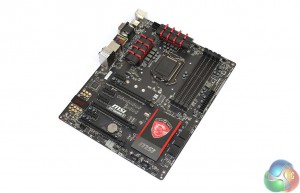
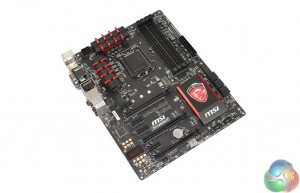
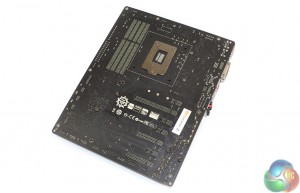
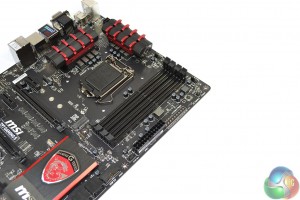
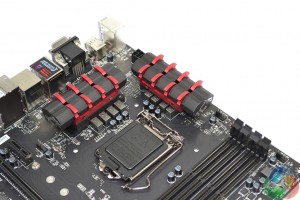
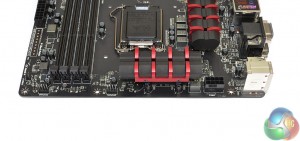
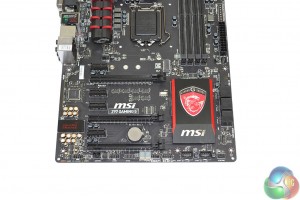
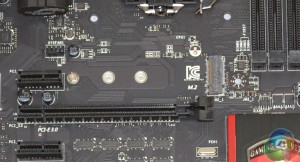
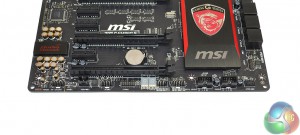
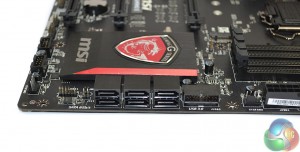
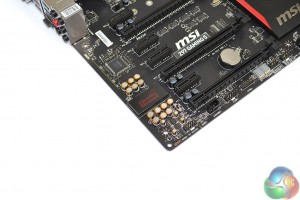
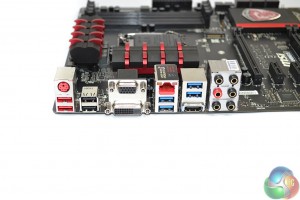
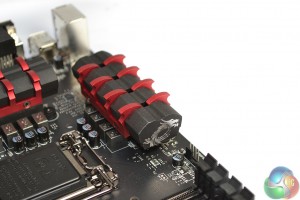
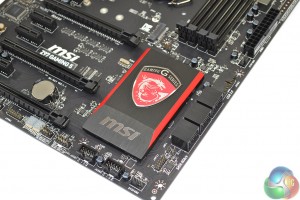
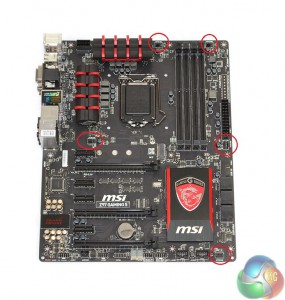

GOod looking board but MSI do need to work on their bioses, my Z87 was very flaky on some settings too. I ended up getting rid of the board and going for an ASUS Sabretooth Z87 board – bios was much better laid out and some of the settings worked the way they should to.
I dont think this board is as nice looking as some of their Z87 boards. Some good information Luke on the bios and the heatsinks – always come here first for reviews on motherboards as you go into much more detail than other sites I visit.
Couple of questions, but first a type-o, 1156 was before Sandy Bridge.
Really good to know about the voltage accuracy with the control centre, and the discrepancy with the bios settings, this is an issue with my current MSI LGA1156 board. Good work on that!
It looks to me as if the overclocked Bioshock results are exactly the same as the stock speed results. Maybe it’s worth testing a game that would actually see the benefit?
I don’t suppose you had the chance to check whether the surround upmix mode in the creative settings would allow you to cleanly upmix a stereo source to all the channels or whether it has to apply a pseudo surround effect?
Deders,
Thanks for pointing out the mistake – I have updated it. And thanks for the feedback.
You’re right – the Bioshock results do not change when CPU frequency is scaled up. I used Metro: Last Light in our Z87 motherboard reviews, but that game did not scale with increased frequency either.
I am currently looking into a game which is more sensitive to CPU frequencies and which is consistent with its results. Many of the popular games are GPU-limited at 1920×1080 (above a certain CPU performance level). And I don’t want to drop the resolution to emphasise CPU performance because I think that 1920×1080 is FAR too popular to justify that. For now, it’s the performance differences (if any) between each motherboard that are important for the gaming results.
I did not have chance to test the surround upmix mode unfortunately. I do not currently have access to my surround sound speakers, either, but audio performance of the motherboards is something that I would like to look into in more depth in the future. It will take a large amount of planning first though.
Luke
Hi. First of all a very good review. It is very interesting for to read this article. Especially the part with the performance of Plextor M6e SSD. I’ve a similar system. It’s a MSI Z97 Gaming 7 and the Plextor M6e SSD m.2. I’ve never reached an performance like in your article. Have you installed the standard msahci driver (Windows 7) or the Intel iastor (RST) driver? I belive my m.2 connector is the problem. Have you special settings in BIOS. Perhaps you some ideas for me.
Thanks in advanced.
Marcel
Can i install my windows in M.2 drive will it boot from there, i found not post over internet but just one unsuccesssful one.
Guys might i add that the MSI additional power that is fed to the molex adapter IS for the rear audio ports and not the USB ports (which already get power ONLY thru the mobo and get a constant 5v). It might make a difference but who knows. Its made that way so it gets a constant clean power feed thru the psu directly instead of thru the 24pin mobo connector.